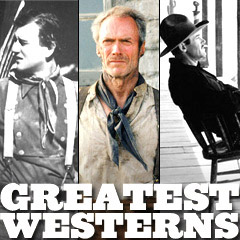
|
Greatest Westerns 1966-1969 |
| Film Title/Year/Director/Length/Studio, Setting (or Time Period) and Brief Description | |
El Dorado (1966)
Considered director Hawks' first derivative film (or remake) of Rio Bravo (1958), followed by another remake Rio Lobo (1970). John Wayne starred as gunfighter Cole Thornton, who was in town to reunite with old friend J. P. Harrah (Robert Mitchum). Thornton had been summoned by evil wealthy landbaron-rancher Bart Jason (Ed Asner) to drive off the rival family of struggling patriarch Kevin MacDonald (R. G. Armstrong) to acquire his water and land. Thornton refused the job, then was ambushed when returning to town from the ranch by MacDonald's son Luke (Johnny Crawford) standing guard. He reflexively fired back and one of his bullets wounded Luke in the gut, and then to his surprise, Luke suicidally shot himself. When Thornton brought the body back to the Jason ranch, before he could explain himself, he was shot by feisty daughter Joey (or Josephine) (Michele Carey), and the bullet lodged dangerously near Thornton's spine. He left town for treatment in the city, although remained partially paralyzed. The story shifted to about a year later, with Thornton returning to El Dorado with a new young buddy/drifter nicknamed Mississippi (or Alan Bourdillion Traherne) (James Caan), a knife-thrower. In town, he met Jason's new hired gun, Nelse McLeod (Christopher George), and learned that friend J.P. had become an alcoholic, after being jilted by a dance-hall girl. Efforts were extended to restore J.P.'s self-respect and cure him of his drinking problem. After some power struggles in town in an attempt to restore peace, the film concluded with the disabled trio in a showdown, joined by grizzled deputy sheriff Bull (Arthur Hunnicutt). Right-hand paralyzed Thornton, semi-crippled and leg-wounded J.P., and concussion-suffering Mississippi killed off Jason, Nelse, and the hired gang, and then settled in town. |
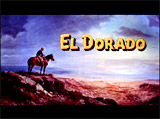
|
The Good, the Bad, and the Ugly
(1966, It.) (aka Il Buono, Il Brutto, Il Battivo)
The third "spaghetti western" classic from Italian director Sergio Leone, again accentuated by Ennio Morricone's trademark score. In this well-known and most famous operatic classic, "The Man with No Name" was now known as Joe or Blondie (Rawhide TV actor Clint Eastwood) - or the "Good" one - a laconic, lone, enigmatic drifter with his familiar poncho. [This third film appeared to be a prequel to the other two films, because it had a Civil War setting previous to the other films, and because Blondie acquired his trademark serape near the end of the film from a dying soldier to whom he lent a last cigarette.] The other two individuals were: Lee Van Cleef's Bad (or Angel Eyes) or Sentenza, a bounty hunter and sadistic hired killer, and Eli Wallach's Ugly (or Tuco Ramirez), a Mexican bandit. The three greedy treasure hunters were searching for a bundle of $200,000 worth of lost or stolen Confederate gold buried in an unmarked grave in Sad Hill Cemetery. The film was noted for loud sound effects, intense close-ups, widescreen cinematography, and intense set-pieces, climaxed with a three-way, five-minute-long, circular graveyard face-off amidst tombstones and grave markers. In the final gunfight, the stranger shot and killed Angel Eyes but spared Tuco and left him his share of the money, but first he had to escape the rope around his neck. Before he rode off, the stranger shot through the rope, leaving Tuco in the middle of nowhere with gold coins - but without a horse. |
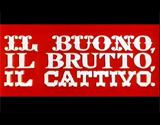 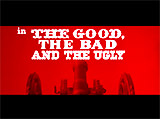
|
The Professionals (1966)
A "Dirty Dozen" type film - about a group of mercenaries on a perilous rescue mission (paid for by a millionaire rancher) who found out that their objective wasn't what they thought it was. The exciting action-western opened with corrupt rancher J. W. Grant (Ralph Bellamy) hiring four professionals (at $10,000 apiece, with $1,000 paid up-front) to rescue his allegedly kidnapped Mexican wife Maria (Claudia Cardinale) from her abductor - ex-Revolution guerrilla leader/bandit Jesus Raza (Jack Palance). The four hired guns were: leader and professional soldier Henry "Rico" Fardan (Lee Marvin), horse wrangler and pack master Hans Ehrengard (Robert Ryan), dynamite expert Bill Dolworth (Burt Lancaster), and black tracker and archer Jake Sharp (Woody Strode). The group crossed the Mexican border and located Raza's hideout deep within a canyon. Although Fardan had an opportunity to kill Raza, Maria interceded and saved him. It was clear that Maria was Raza's willing mistress. Ruthless rancher Grant had acquired Maria for an arranged marriage, but she had escaped and returned to lover Raza in his desert stronghold in Mexico. At the border to claim their reward in the film's conclusion, the professionals turned over a wounded Raza and Maria to Grant, then changed their minds and freed the two. The final dialogue was priceless: Grant called Fardan a bastard, to which Fardan retorted: "Yes, sir, in my case an accident of birth. But you, sir, you are a self-made man." |
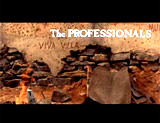
|
The Shooting (1966)
This low-budget B-movie, considered one of the first off-beat, stylized existential 'acid westerns,' was never released theatrically. It was an arthouse-type road-quest film that finally found a cult audience after being released to TV in 1968, and after actor Jack Nicholson came to fame. Universally, viewers were puzzled by its strange ending. It has been conjectured that the western was about the JFK assassination and that the ending was about the capture of Lee Harvey Oswald. The film opened in a mining camp, where scruffy, grizzled ex-bounty hunter Willett Gashade (Warren Oates) was partnered with foolish cohort Coley Boyard (Will Hutchins), and friend Leland Drum (B.J. Merholz). Gashade's look-alike brother Coin Gashade (also Warren Oates) had recently fled from camp and was missing. Slow-witted and fearful Coley told Willett that Drum had been murdered by an unidentified killer. Willett and Coley were now on a hunt - but the identity of the wanted man the two were hunting down was unclear, as was the motive for the hunt (there was only a brief mention of gravely injured (or killed) people in town, including maybe a child). Willett and Coley were hired for $1,000 to escort a mysterious, enigmatic nameless woman (Millie Perkins) to a town across the desert called Kingsley. She had just shot and killed her seemingly-healthy horse. Paranoia soon set in, as the two suspected that the empowered woman was leaving clues for a cocky, black-clad, leather-vested menacing hired gun named Billy Spear (Jack Nicholson) who seemed to be following them. The And then unexpectedly, the intimidating and threatening Spear visited them at camp one night and joined their hunt. During their unusual doomed trek in the harsh desert climate when they became short on horses and water, Coley was shot dead by Spear, and all of their horses died. Willett found an opportunity to wrestle with and attack Spear and crush his gun-shooting hand with a rock. And then on the side of a rock formation, as Willett was following after the woman (who was following another unidentified man), she exchanged rapid gun-fire with the man and they killed each other. When Willett came upon the dead man, he spoke the name "Coin," realizing that the corpse belonged to his own twin brother. Spear continued to be delirious in the hot sun from sunstroke. |

|
Hombre (1967)
A revisionist, liberal-minded western with minor amounts of dialogue - with the theme of racial prejudice and injustice against outcast Native Americans. A story with some similarities to John Ford's Stagecoach (1939). With Paul Newman starring as John Russell, an Apache-raised white man on a reservation. He traded an inherited boarding-house from his adoptive father for a herd of horses, then took a stagecoach ride out of town with others back to the Indian reservation (he was forced to sit on top, not with the others). The paying passengers included: widowed, fiery ex-boarding house manager Jessie Brown (Diane Cilento), Mexican driver-friend Henry Mendez (Martin Balsam), bigoted Indian agent Dr. Alexander Favor (Fredric March) and trophy wife Audra (Barbara Rush), a bickering, unhappy newly-married couple (Billy Lee Black (Peter Lazer) and Doris Blake (Margaret Blye)), and ominous tough-guy stranger Cicero Grimes (Richard Boone). During the journey, the coach was robbed by Grimes' gang of gunmen, knowing that Favor had embezzled $12,000 from US government funds intended for Indian beef contracts, and Audra was taken as hostage. During the robbery, Russell shot and killed two outlaws and retrieved the sack of money, and then led the group to seek refuge in an abandoned mining cabin. The next day, Russell refused to give the outlaws the sack of money in exchange for Audra. Instead, with a last-minute fatalistic and doomed decision, he faced and gunned down all the bandits while trying to rescue Audra (staked out to die in the sun), but nobly died in the process. |

|
Hang 'Em High (1968)
Director Ted Post's violent, revisionist revenge western about frontier justice was star Clint Eastwood's first American film in a lead role after starring in Sergio Leone's trilogy of "spaghetti westerns." It was a film co-produced with Eastwood's own production company Malpaso. Post had previously directed a few dozen episodes of the CBS-TV show Rawhide (with Eastwood starring as Rowdy Yates) in the late 1950s. The tagline was: "Eastwood is Judge, Jury and Executioner!" In the opening scene, cowpoke and ex-St. Louis lawman Jed Cooper (Clint Eastwood), a victim of mistaken identity, was thought to be a murdering rustler. He was lynched by a gang of nine vigilantes led by crooked law and order judge Captain Wilson (Ed Begley). Left for dead, Cooper nonetheless survived when discovered and cut down by Federal Marshal Dave Bliss (Ben Johnson), and then brought to the town of Fort Grant. There while held in jail, notorious territorial Judge Fenton (Pat Hingle) admitted to Cooper that they had found the real culprit, McCloud (who was hanged), and Cooper was exonerated and appointed as a deputy US Marshal. However, he was warned about seeking personal justice and taking the law into his own hands. For the remainder of the film, Cooper went after the 'hanging jury' to punish them for his wrongful treatment. Those involved in the "Cooper Hanging Party" included Reno (Joseph Sirola), Jenkins (Bob Steele), blacksmith Matt Stone (Alan Hale Jr.), the ringleader Miller (Bruce Dern), Tommy (Jonathan Lippe), Loomis (L.Q. Jones), Maddow (Russell Thorson), and Charlie Blackfoot (Ned Romero). There were questions raised about the varying degrees of guilt of the vigilantes and other rustlers - it appeared that only Miller had murdered others - but Judge Fenton was interested in a mass public execution of everyone on a gallows, in order to make a show of strict enforcement of law and order in the growing territory. Cooper was supported during his quest by love interest and widowed rape victim Rachel Warren (Inger Stevens), the proprietor-shopkeeper of a general store in town. Eventually, most of Wilson's gang deserted him, and he suicidally hanged himself before Cooper could kill him. In exchange for the pardon and release of Jenkins, one of the ill and repentent prisoners, Cooper agreed to remain in town as a Marshal rather than quit. |
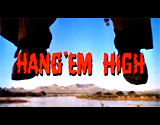
|
Once Upon a Time in the West (1968,
It.) (aka C'era Una Volta il West)
This was director Leone's true western epic masterpiece - a revisionistic revenge western filmed in John Ford's favored location, Monument Valley, and in Spain. It featured a great musical score (and harmonica melody) by Ennio Morricone, and told about the coming of the railroad and the struggle between various groups for monopolistic control - with numerous instances of homage to earlier traditional Hollywood westerns. And it also brought together all the themes, characterizations, and experimental visuals from his own previous three films - the successful "spaghetti western" trio of films from 1964 to 1966 starring Clint Eastwood as "The Man With No Name." Its widescreen opening sequence has been justly celebrated - a tense, detailed, almost-wordless standoff at noon in the midday sun between three hired gunmen (Snaky (Jack Elam), Stony (Woody Strode), and Knuckles (Al Mulock)) at a train station, marked by only exaggerated sound effects, wide closeups, and the arrival of the train with a harmonica-playing killer named "Harmonica" (Charles Bronson). The plot was about a beautiful widow, reformed ex-New Orleans prostitute Jill McBain (Claudia Cardinale), who arrived at her Sweetwater homestead in the desert - a key location where trains crossing the continent would have to stop for water. Just before her arrival, her new husband, local Irish businessman Brett McBain (Frank Wolff) and his three children had just been massacred (due to a railroad dispute) - it was a cold-blooded and merciless ambush and murder led by blue-eyed, black-hatted, railroad company employee Frank (American icon-actor Henry Fonda in an about-face role as a villainous, sadistic murderer). Frank was taking orders from sickly, crippled and corrupt railroad tycoon Morton, aka "Mr. Choo Choo" (Gabriele Ferzetti). The McBain murders were set up to blame honorable yet grizzled escaped con and half-breed, wily scoundrel Cheyenne (Jason Robards). Jill received help from the mysterious harmonica-playing stranger and protector/escaped con Cheyenne after the brutal killings, to thwart efforts of others to take her inherited strategic plot of land. The film concluded with a classic confrontational ending - a showdown duel between Harmonica and Frank, that revealed (in a fateful, revelatory flashback) the reason for Harmonica's life-long search for revenge against Frank. In the final sequence, a mortally-wounded Cheyenne (earlier he had been shot in the abdomen during Cheyenne's rescue) spoke his final words to Harmonica, who then rode away (with a second horse carrying the slumped-over corpse of Cheyenne). Meanwhile, Jill confidently strode to the Sweetwater railway station to offer water to the laborers and track-laying crews before the end credits began to roll. |
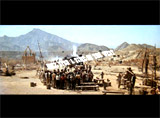
|
Butch Cassidy and the Sundance Kid (1969)
A light-hearted, entertaining, fast-paced, action-comic, revisionistic western (and buddy film) set at the turn of the century, with Burt Bacharach's famous soundtrack highlighted by "Raindrops Keep Falling on My Head." Loosely based on the two charismatic, anti-hero title characters: Butch Cassidy (Paul Newman) (alias Robert LeRoy Parker) and the Sundance Kid (Robert Redford) (alias Harry Longabaugh), buddy-members of the Hole-in-the-Wall gang. In the early 1900s, they had come toward the tail-end of a long stream of bank/train robbers and highwaymen in the 19th century. The two were relentlessly pursued by authorities, led by renowned Indian tracker "Lord Baltimore" and relentless lawman Joe LeFors, paid for by Union Pacific head E. H. Harriman. To make their escape, the train-robbing outlaws fled to Bolivia (after a brief stopover in New York City) with the Kid's schoolteacher-lover Etta Place (Katharine Ross) - hoping to find better luck. A deadly Brazilian posse surrounded them, leading to their violent freeze-framed deaths. |
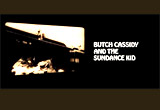
|
True Grit (1969)
Known as being the only film to bring John Wayne a Best Actor Oscar (a sentimental honor for his many years of western movie-making), in the role of a pot-bellied, aging, one-eyed, cantankerous marshal. Wayne reprised his role as U.S. Marshal Reuben J. "Rooster" Cogburn in a sequel, Rooster Cogburn (1975) opposite Katharine Hepburn. The film was remade as True Grit (2010) by the Coen Brothers. The film's plot was about headstrong 14-year-old Mattie Ross (Kim Darby), who hired the gruff old Cogburn to find fugitive Tom Chaney (Jeff Corey) and avenge the death of her father Frank Ross. Also tracking Chaney in Indian territory was $1,500 reward-seeking Texas Ranger La Boeuf (Glen Campbell in his first major big-screen role). Chaney's gang-members included leader Ned Pepper (Robert Duvall) and two horse thieves Quincy (Jeremy Slate), and Moon (Dennis Hopper). With Mattie joining Cogburn and La Boeuf, the trio tracked Chaney across the border to Pepper's hideout where a deadly shootout occurred, but Pepper escaped. Later during their pursuit when Mattie was taken hostage by Chaney himself, she was able to shoot the outlaw and wound him, while Cogburn (who was himself wounded) and La Boeuf finished off Pepper. In another confrontation with Chaney, Mattie wounded him again (and Cogburn killed him) although La Boeuf was struck on the head with a rock and mortally wounded. A rattlesnake bite almost cost Mattie's life, but Cogburn sped with her on horseback to a physician who saved her life. Later, she promised him that he could be buried next to her family's cemetery plot after his death. |
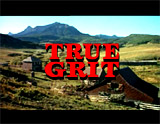
|
The
Wild Bunch (1969)
One of the most controversial westerns of its time, due to director/co-writer Sam Peckinpah's unrelenting, graphically-brutal, slow-motion violence and savagely-explicit carnage. It earned him the nickname of "Bloody Sam" thanks to its over-the-top orgiastic killings. The breakthrough western was hailed for its truly realistic and reinterpreted vision of the dying West in the early 20th century. At the time, it was considered a veiled criticism of the Vietnam War. This much-imitated film was book-ended by two extraordinary sequences, both shoot-out massacres with cinematically visceral, intense blood-letting. Each scene was choreographed as a dance with semi-slow-motion bodies spurting blood while being torn apart by bullets (from implanted explosive squibs). The multiple cameras and montage editing made these scenes as aesthetically breathtaking as they were disturbing. The opening was an impressive botched bank robbery and ambush, introducing its unrelenting, bleak tale of a group of aging, scroungy outlaws (the 'wild bunch'). They were bound by a private code of honor, camaraderie and friendship, but at odds with the society of 1913. The lone band of men were led by Pike Bishop (William Holden), who was joined by second in command Dutch Engstrom (Ernest Borgnine), brothers Lyle and Tector Gorch (Warren Oates and Ben Johnson), and Sykes (Edmond O'Brien). They had come to the end of the line after taking flight to Mexico. They were no longer living under the same rules in the Old West. They were relentlessly stalked by inept bounty hunters, one of whom was Pike's former friend Deke Thornton (Robert Ryan), who would rather side with the outlaws if it weren't for the threat of being sent back to Yuma Prison. In the bloody conclusion, the Wild Bunch faced an over-the-top massacre at the hands of a corrupt and malicious South American General Mapache (Emilio Fernandez) and his guerrilla army during the Mexican Revolution, when Angel (Jaime Sanchez) jeopardized their livelihood. |
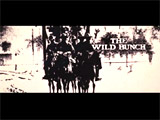
|
(chronological by film title) Introduction | Silents-1930s | 1940s | 1950-1955 | 1956-1959 | 1960-1965 1966-1969 | 1970s | 1980s-1990s | 2000s | 2010s |